Manufacture of large uniform droplets using rotating membrane emulsification
- 格式:pdf
- 大小:575.73 KB
- 文档页数:7
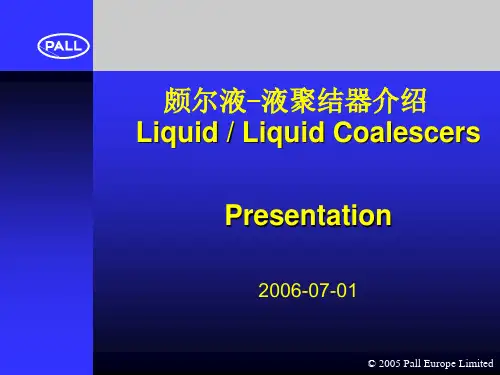
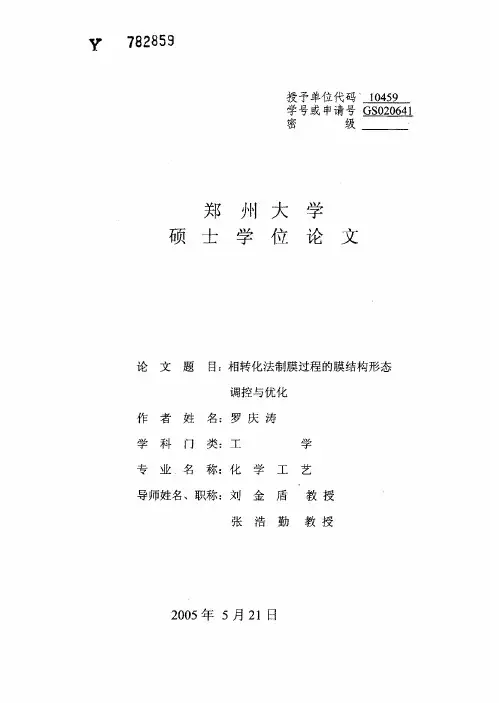
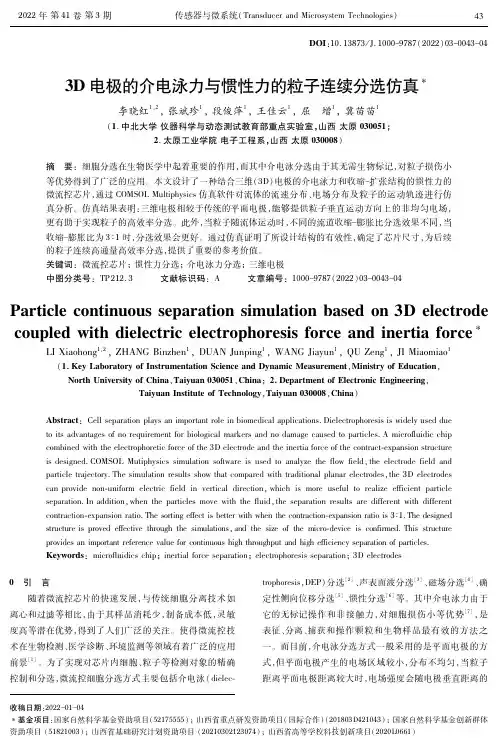
2022年第41卷第3期 传感器与微系统(TransducerandMicrosystemTechnologies)DOI:10.13873/J.1000—9787(2022)03—0043—043D电极的介电泳力与惯性力的粒子连续分选仿真李晓红1,2,张斌珍1,段俊萍1,王佳云1,屈 增1,冀苗苗1(1.中北大学仪器科学与动态测试教育部重点实验室,山西太原030051;2.太原工业学院电子工程系,山西太原030008)摘 要:细胞分选在生物医学中起着重要的作用,而其中介电泳分选由于其无需生物标记,对粒子损伤小等优势得到了广泛的应用。
本文设计了一种结合三维(3D)电极的介电泳力和收缩—扩张结构的惯性力的微流控芯片,通过COMSOLMultiphysics仿真软件对流体的流速分布、电场分布及粒子的运动轨迹进行仿真分析。
仿真结果表明:三维电极相较于传统的平面电极,能够提供粒子垂直运动方向上的非均匀电场,更有助于实现粒子的高效率分选。
此外,当粒子随流体运动时,不同的流道收缩—膨胀比分选效果不同,当收缩—膨胀比为361时,分选效果会更好。
通过仿真证明了所设计结构的有效性,确定了芯片尺寸,为后续的粒子连续高通量高效率分选,提供了重要的参考价值。
关键词:微流控芯片;惯性力分选;介电泳力分选;三维电极中图分类号:TP212.3 文献标识码:A 文章编号:1000—9787(2022)03—0043—04Particlecontinuousseparationsimulationbasedon3DelectrodecoupledwithdielectricelectrophoresisforceandinertiaforceLIXiaohong1,2,ZHANGBinzhen1,DUANJunping1,WANGJiayun1,QUZeng1,JIMiaomiao1(1.KeyLaboratoryofInstrumentationScienceandDynamicMeasurement,MinistryofEducation,NorthUniversityofChina,Taiyuan030051,China;2.DepartmentofElectronicEngineering,TaiyuanInstituteofTechnology,Taiyuan030008,China)Abstract:Cellseparationplaysanimportantroleinbiomedicalapplications.Dielectrophoresisiswidelyusedduetoitsadvantagesofnorequirementforbiologicalmarkersandnodamagecausedtoparticles.Amicrofluidicchipcombinedwiththeelectrophoreticforceofthe3Delectrodeandtheinertiaforceofthecontract expansionstructureisdesigned.COMSOLMutiphysicssimulationsoftwareisusedtoanalyzetheflowfield,theelectrodefieldandparticletrajectory.Thesimulationresultsshowthatcomparedwithtraditionalplanarelectrodes,the3Delectrodescanprovidenon uniformelectricfieldinverticaldirection,whichismoreusefultorealizeefficientparticleseparation.Inaddition,whentheparticlesmovewiththefluid,theseparationresultsaredifferentwithdifferentcontraction expansionratio.Thesortingeffectisbetterwithwhenthecontraction expansionratiois361.Thedesignedstructureisprovedeffectivethroughthesimulations,andthesizeofthemicro deviceisconfirmed.Thisstructureprovidesanimportantreferencevalueforcontinuoushighthroughputandhighefficiencyseparationofparticles.Keywords:microfluidicschip;inertialforceseparation;electrophoresisseparation;3Delectrodes0 引 言随着微流控芯片的快速发展,与传统细胞分离技术如离心和过滤等相比,由于其样品消耗少,制备成本低,灵敏度高等潜在优势,得到了人们广泛的关注。
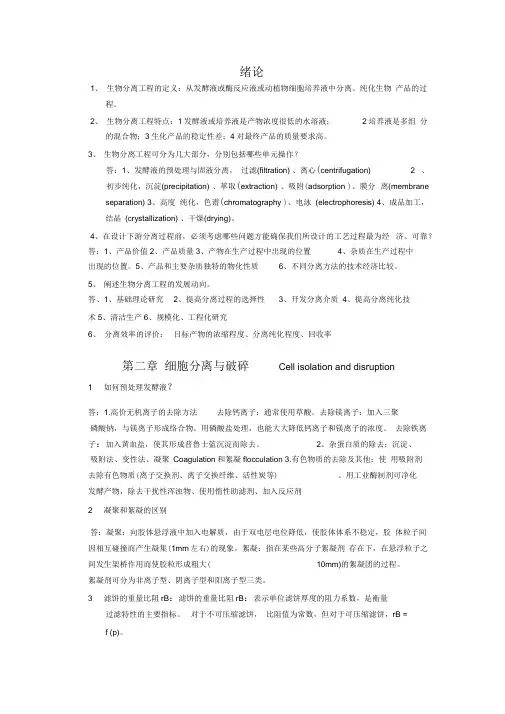
绪论1、生物分离工程的定义:从发酵液或酶反应液或动植物细胞培养液中分离、纯化生物产品的过程。
2、生物分离工程特点:1发酵液或培养液是产物浓度很低的水溶液;2培养液是多组分的混合物;3生化产品的稳定性差;4对最终产品的质量要求高。
3、生物分离工程可分为几大部分,分别包括哪些单元操作?答:1、发酵液的预处理与固液分离,过滤(filtration) 、离心(centrifugation) 2、初步纯化,沉淀(precipitation) 、萃取(extraction) 、吸附(adsorption )、膜分离(membrane separation) 3、高度纯化,色谱(chromatography )、电泳(electrophoresis) 4、成品加工,结晶(crystallization) 、干燥(drying)。
4、在设计下游分离过程前,必须考虑哪些问题方能确保我们所设计的工艺过程最为经济、可靠?答:1、产品价值2、产品质量3、产物在生产过程中出现的位置4、杂质在生产过程中出现的位置。
5、产品和主要杂质独特的物化性质6、不同分离方法的技术经济比较。
5、阐述生物分离工程的发展动向。
答、1、基础理论研究2、提高分离过程的选择性3、开发分离介质4、提高分离纯化技术5、清洁生产6、规模化、工程化研究6、分离效率的评价:目标产物的浓缩程度、分离纯化程度、回收率第二章细胞分离与破碎Cell isolation and disruption1 如何预处理发酵液?答:1.高价无机离子的去除方法去除钙离子:通常使用草酸。
去除镁离子:加入三聚磷酸钠,与镁离子形成络合物。
用磷酸盐处理,也能大大降低钙离子和镁离子的浓度。
去除铁离子:加入黄血盐,使其形成普鲁士蓝沉淀而除去。
2、杂蛋白质的除去:沉淀、吸附法、变性法、凝聚Coagulation和絮凝flocculation 3.有色物质的去除及其他:使用吸附剂去除有色物质(离子交换剂、离子交换纤维、活性炭等) 、用工业酶制剂可净化发酵产物,除去干扰性浑浊物、使用惰性助滤剂、加入反应剂2 凝聚和絮凝的区别答:凝聚:向胶体悬浮液中加入电解质,由于双电层电位降低,使胶体体系不稳定,胶体粒子间因相互碰撞而产生凝集(1mm左右)的现象。
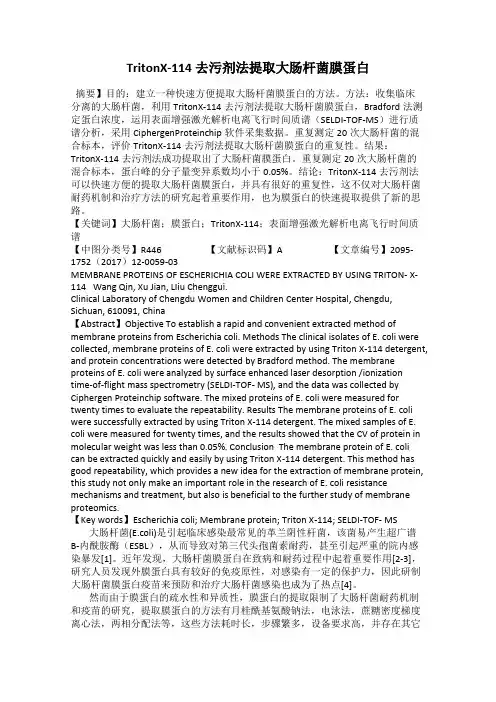
TritonX-114去污剂法提取大肠杆菌膜蛋白摘要】目的:建立一种快速方便提取大肠杆菌膜蛋白的方法。
方法:收集临床分离的大肠杆菌,利用TritonX-114去污剂法提取大肠杆菌膜蛋白,Bradford法测定蛋白浓度,运用表面增强激光解析电离飞行时间质谱(SELDI-TOF-MS)进行质谱分析,采用CiphergenProteinchip软件采集数据。
重复测定20次大肠杆菌的混合标本,评价TritonX-114去污剂法提取大肠杆菌膜蛋白的重复性。
结果:TritonX-114去污剂法成功提取出了大肠杆菌膜蛋白。
重复测定20次大肠杆菌的混合标本,蛋白峰的分子量变异系数均小于0.05%。
结论:TritonX-114去污剂法可以快速方便的提取大肠杆菌膜蛋白,并具有很好的重复性,这不仅对大肠杆菌耐药机制和治疗方法的研究起着重要作用,也为膜蛋白的快速提取提供了新的思路。
【关键词】大肠杆菌;膜蛋白;TritonX-114;表面增强激光解析电离飞行时间质谱【中图分类号】R446 【文献标识码】A 【文章编号】2095-1752(2017)12-0059-03MEMBRANE PROTEINS OF ESCHERICHIA COLI WERE EXTRACTED BY USING TRITON- X-114 Wang Qin, Xu Jian, LIiu Chenggui.Clinical Laboratory of Chengdu Women and Children Center Hospital, Chengdu, Sichuan, 610091, China【Abstract】Objective To establish a rapid and convenient extracted method of membrane proteins from Escherichia coli. Methods The clinical isolates of E. coli were collected, membrane proteins of E. coli were extracted by using Triton X-114 detergent, and protein concentrations were detected by Bradford method. The membrane proteins of E. coli were analyzed by surface enhanced laser desorption /ionizationtime-of-flight mass spectrometry (SELDI-TOF- MS), and the data was collected by Ciphergen Proteinchip software. The mixed proteins of E. coli were measured for twenty times to evaluate the repeatability. Results The membrane proteins of E. coli were successfully extracted by using Triton X-114 detergent. The mixed samples of E. coli were measured for twenty times, and the results showed that the CV of protein in molecular weight was less than 0.05%. Conclusion The membrane protein of E. coli can be extracted quickly and easily by using Triton X-114 detergent. This method has good repeatability, which provides a new idea for the extraction of membrane protein, this study not only make an important role in the research of E. coli resistance mechanisms and treatment, but also is beneficial to the further study of membrane proteomics.【Key words】Escherichia coli; Membrane protein; Triton X-114; SELDI-TOF- MS 大肠杆菌(E.coli)是引起临床感染最常见的革兰阴性杆菌,该菌易产生超广谱B-内酰胺酶(ESBL),从而导致对第三代头孢菌素耐药,甚至引起严重的院内感染暴发[1]。
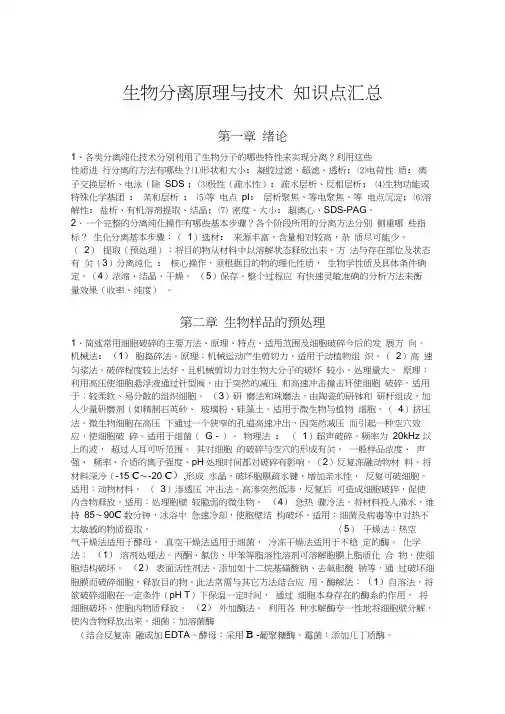
生物分离原理与技术知识点汇总第一章绪论1、各类分离纯化技术分别利用了生物分子的哪些特性来实现分离?利用这些性质进行分离的方法有哪些?⑴形状和大小:凝胶过滤、超滤、透析;⑵电荷性质:离子交换层析、电泳(除SDS ;⑶极性(疏水性):疏水层析、反相层析;⑷生物功能或特殊化学基团:亲和层析;⑸等电点pI:层析聚焦、等电聚焦、等电点沉淀;⑹溶解性:盐析、有机溶剂提取、结晶;⑺ 密度、大小:超离心、SDS-PAG。
2、一个完整的分离纯化操作有哪些基本步骤?各个阶段所用的分离方法分别侧重哪些指标?生化分离基本步骤:(1)选材:来源丰富,含量相对较高,杂质尽可能少。
(2)提取(预处理):将目的物从材料中以溶解状态释放出来,方法与存在部位及状态有关(3)分离纯化:核心操作,须根据目的物的理化性质,生物学性质及具体条件确定。
(4)浓缩、结晶、干燥。
(5)保存。
整个过程应有快速灵敏准确的分析方法来衡量效果(收率、纯度)。
第二章生物样品的预处理1、简述常用细胞破碎的主要方法、原理、特点、适用范围及细胞破碎今后的发展方向。
机械法:(1)胞捣碎法。
原理:机械运动产生剪切力,适用于动植物组织。
(2)高速匀浆法。
破碎程度较上法好,且机械剪切力对生物大分子的破坏较小,处理量大。
原理:利用高压使细胞悬浮液通过针型阀,由于突然的减压和高速冲击撞击环使细胞破碎。
适用于:较柔软、易分散的组织细胞。
(3)研磨法和珠磨法。
由陶瓷的研钵和研杆组成,加入少量研磨剂(如精制石英砂、玻璃粉、硅藻土。
适用于微生物与植物细胞。
(4)挤压法。
微生物细胞在高压下通过一个狭窄的孔道高速冲出,因突然减压而引起一种空穴效应,使细胞破碎。
适用于细菌(G - )。
物理法:(1)超声破碎。
频率为20kHz 以上的波,超过人耳可听范围。
其对细胞的破碎与空穴的形成有关。
一般样品浓度、声强、频率、介质的离子强度、pH处理时间都对破碎有影响。
(2)反复冻融动物材料。
将材料深冷(-15 C〜-20 C),形成水晶,破坏胞膜疏水键,增加亲水性,反复可破细胞。
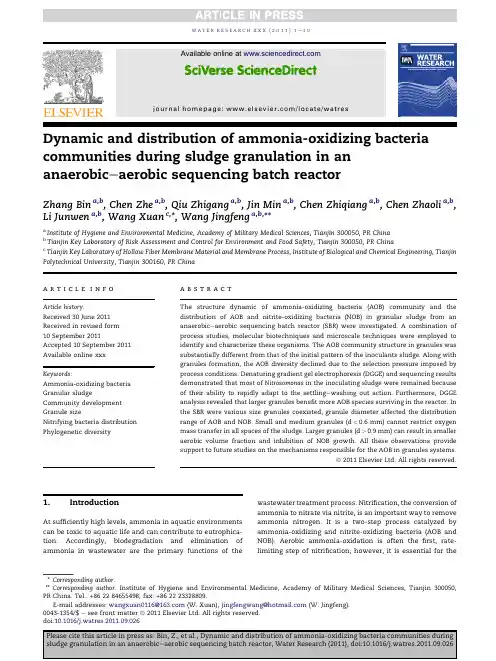
Dynamic and distribution of ammonia-oxidizing bacteria communities during sludge granulation in an anaerobic e aerobic sequencing batch reactorZhang Bin a ,b ,Chen Zhe a ,b ,Qiu Zhigang a ,b ,Jin Min a ,b ,Chen Zhiqiang a ,b ,Chen Zhaoli a ,b ,Li Junwen a ,b ,Wang Xuan c ,*,Wang Jingfeng a ,b ,**aInstitute of Hygiene and Environmental Medicine,Academy of Military Medical Sciences,Tianjin 300050,PR China bTianjin Key Laboratory of Risk Assessment and Control for Environment and Food Safety,Tianjin 300050,PR China cTianjin Key Laboratory of Hollow Fiber Membrane Material and Membrane Process,Institute of Biological and Chemical Engineering,Tianjin Polytechnical University,Tianjin 300160,PR Chinaa r t i c l e i n f oArticle history:Received 30June 2011Received in revised form 10September 2011Accepted 10September 2011Available online xxx Keywords:Ammonia-oxidizing bacteria Granular sludgeCommunity development Granule sizeNitrifying bacteria distribution Phylogenetic diversitya b s t r a c tThe structure dynamic of ammonia-oxidizing bacteria (AOB)community and the distribution of AOB and nitrite-oxidizing bacteria (NOB)in granular sludge from an anaerobic e aerobic sequencing batch reactor (SBR)were investigated.A combination of process studies,molecular biotechniques and microscale techniques were employed to identify and characterize these organisms.The AOB community structure in granules was substantially different from that of the initial pattern of the inoculants sludge.Along with granules formation,the AOB diversity declined due to the selection pressure imposed by process conditions.Denaturing gradient gel electrophoresis (DGGE)and sequencing results demonstrated that most of Nitrosomonas in the inoculating sludge were remained because of their ability to rapidly adapt to the settling e washing out action.Furthermore,DGGE analysis revealed that larger granules benefit more AOB species surviving in the reactor.In the SBR were various size granules coexisted,granule diameter affected the distribution range of AOB and NOB.Small and medium granules (d <0.6mm)cannot restrict oxygen mass transfer in all spaces of the rger granules (d >0.9mm)can result in smaller aerobic volume fraction and inhibition of NOB growth.All these observations provide support to future studies on the mechanisms responsible for the AOB in granules systems.ª2011Elsevier Ltd.All rights reserved.1.IntroductionAt sufficiently high levels,ammonia in aquatic environments can be toxic to aquatic life and can contribute to eutrophica-tion.Accordingly,biodegradation and elimination of ammonia in wastewater are the primary functions of thewastewater treatment process.Nitrification,the conversion of ammonia to nitrate via nitrite,is an important way to remove ammonia nitrogen.It is a two-step process catalyzed by ammonia-oxidizing and nitrite-oxidizing bacteria (AOB and NOB).Aerobic ammonia-oxidation is often the first,rate-limiting step of nitrification;however,it is essential for the*Corresponding author .**Corresponding author.Institute of Hygiene and Environmental Medicine,Academy of Military Medical Sciences,Tianjin 300050,PR China.Tel.:+862284655498;fax:+862223328809.E-mail addresses:wangxuan0116@ (W.Xuan),jingfengwang@ (W.Jingfeng).Available online atjournal homepage:/locate/watresw a t e r r e s e a r c h x x x (2011)1e 100043-1354/$e see front matter ª2011Elsevier Ltd.All rights reserved.doi:10.1016/j.watres.2011.09.026removal of ammonia from the wastewater(Prosser and Nicol, 2008).Comparative analyses of16S rRNA sequences have revealed that most AOB in activated sludge are phylogeneti-cally closely related to the clade of b-Proteobacteria (Kowalchuk and Stephen,2001).However,a number of studies have suggested that there are physiological and ecological differences between different AOB genera and lineages,and that environmental factors such as process parameter,dis-solved oxygen,salinity,pH,and concentrations of free ammonia can impact certain species of AOB(Erguder et al., 2008;Kim et al.,2006;Koops and Pommerening-Ro¨ser,2001; Kowalchuk and Stephen,2001;Shi et al.,2010).Therefore, the physiological activity and abundance of AOB in waste-water processing is critical in the design and operation of waste treatment systems.For this reason,a better under-standing of the ecology and microbiology of AOB in waste-water treatment systems is necessary to enhance treatment performance.Recently,several developed techniques have served as valuable tools for the characterization of microbial diversity in biological wastewater treatment systems(Li et al., 2008;Yin and Xu,2009).Currently,the application of molec-ular biotechniques can provide clarification of the ammonia-oxidizing community in detail(Haseborg et al.,2010;Tawan et al.,2005;Vlaeminck et al.,2010).In recent years,the aerobic granular sludge process has become an attractive alternative to conventional processes for wastewater treatment mainly due to its cell immobilization strategy(de Bruin et al.,2004;Liu et al.,2009;Schwarzenbeck et al.,2005;Schwarzenbeck et al.,2004a,b;Xavier et al.,2007). Granules have a more tightly compact structure(Li et al.,2008; Liu and Tay,2008;Wang et al.,2004)and rapid settling velocity (Kong et al.,2009;Lemaire et al.,2008).Therefore,granular sludge systems have a higher mixed liquid suspended sludge (MLSS)concentration and longer solid retention times(SRT) than conventional activated sludge systems.Longer SRT can provide enough time for the growth of organisms that require a long generation time(e.g.,AOB).Some studies have indicated that nitrifying granules can be cultivated with ammonia-rich inorganic wastewater and the diameter of granules was small (Shi et al.,2010;Tsuneda et al.,2003).Other researchers reported that larger granules have been developed with the synthetic organic wastewater in sequencing batch reactors(SBRs)(Li et al., 2008;Liu and Tay,2008).The diverse populations of microor-ganisms that coexist in granules remove the chemical oxygen demand(COD),nitrogen and phosphate(de Kreuk et al.,2005). However,for larger granules with a particle diameter greater than0.6mm,an outer aerobic shell and an inner anaerobic zone coexist because of restricted oxygen diffusion to the granule core.These properties of granular sludge suggest that the inner environment of granules is unfavorable to AOB growth.Some research has shown that particle size and density induced the different distribution and dominance of AOB,NOB and anam-mox(Winkler et al.,2011b).Although a number of studies have been conducted to assess the ecology and microbiology of AOB in wastewater treatment systems,the information on the dynamics,distribution,and quantification of AOB communities during sludge granulation is still limited up to now.To address these concerns,the main objective of the present work was to investigate the population dynamics of AOB communities during the development of seedingflocs into granules,and the distribution of AOB and NOB in different size granules from an anaerobic e aerobic SBR.A combination of process studies,molecular biotechniques and microscale techniques were employed to identify and char-acterize these organisms.Based on these approaches,we demonstrate the differences in both AOB community evolu-tion and composition of theflocs and granules co-existing in the SBR and further elucidate the relationship between distribution of nitrifying bacteria and granule size.It is ex-pected that the work would be useful to better understand the mechanisms responsible for the AOB in granules and apply them for optimal control and management strategies of granulation systems.2.Material and methods2.1.Reactor set-up and operationThe granules were cultivated in a lab-scale SBR with an effective volume of4L.The effective diameter and height of the reactor was10cm and51cm,respectively.The hydraulic retention time was set at8h.Activated sludge from a full-scale sewage treat-ment plant(Jizhuangzi Sewage Treatment Works,Tianjin, China)was used as the seed sludge for the reactor at an initial sludge concentration of3876mg LÀ1in MLSS.The reactor was operated on6-h cycles,consisting of2-min influent feeding,90-min anaerobic phase(mixing),240-min aeration phase and5-min effluent discharge periods.The sludge settling time was reduced gradually from10to5min after80SBR cycles in20days, and only particles with a settling velocity higher than4.5m hÀ1 were retained in the reactor.The composition of the influent media were NaAc(450mg LÀ1),NH4Cl(100mg LÀ1),(NH4)2SO4 (10mg LÀ1),KH2PO4(20mg LÀ1),MgSO4$7H2O(50mg LÀ1),KCl (20mg LÀ1),CaCl2(20mg LÀ1),FeSO4$7H2O(1mg LÀ1),pH7.0e7.5, and0.1mL LÀ1trace element solution(Li et al.,2007).Analytical methods-The total organic carbon(TOC),NHþ4e N, NOÀ2e N,NOÀ3e N,total nitrogen(TN),total phosphate(TP) concentration,mixed liquid suspended solids(MLSS) concentration,and sludge volume index at10min(SVI10)were measured regularly according to the standard methods (APHA-AWWA-WEF,2005).Sludge size distribution was determined by the sieving method(Laguna et al.,1999).Screening was performed with four stainless steel sieves of5cm diameter having respective mesh openings of0.9,0.6,0.45,and0.2mm.A100mL volume of sludge from the reactor was sampled with a calibrated cylinder and then deposited on the0.9mm mesh sieve.The sample was subsequently washed with distilled water and particles less than0.9mm in diameter passed through this sieve to the sieves with smaller openings.The washing procedure was repeated several times to separate the gran-ules.The granules collected on the different screens were recovered by backwashing with distilled water.Each fraction was collected in a different beaker andfiltered on quantitative filter paper to determine the total suspended solid(TSS).Once the amount of total suspended solid(TSS)retained on each sieve was acquired,it was reasonable to determine for each class of size(<0.2,[0.2e0.45],[0.45e0.6],[0.6e0.9],>0.9mm) the percentage of the total weight that they represent.w a t e r r e s e a r c h x x x(2011)1e10 22.2.DNA extraction and nested PCR e DGGEThe sludge from approximately8mg of MLSS was transferred into a1.5-mL Eppendorf tube and then centrifuged at14,000g for10min.The supernatant was removed,and the pellet was added to1mL of sodium phosphate buffer solution and aseptically mixed with a sterilized pestle in order to detach granules.Genomic DNA was extracted from the pellets using E.Z.N.A.äSoil DNA kit(D5625-01,Omega Bio-tek Inc.,USA).To amplify ammonia-oxidizer specific16S rRNA for dena-turing gradient gel electrophoresis(DGGE),a nested PCR approach was performed as described previously(Zhang et al., 2010).30m l of nested PCR amplicons(with5m l6Âloading buffer)were loaded and separated by DGGE on polyacrylamide gels(8%,37.5:1acrylamide e bisacrylamide)with a linear gradient of35%e55%denaturant(100%denaturant¼7M urea plus40%formamide).The gel was run for6.5h at140V in 1ÂTAE buffer(40mM Tris-acetate,20mM sodium acetate, 1mM Na2EDTA,pH7.4)maintained at60 C(DCodeäUniversal Mutation Detection System,Bio-Rad,Hercules,CA, USA).After electrophoresis,silver-staining and development of the gels were performed as described by Sanguinetti et al. (1994).These were followed by air-drying and scanning with a gel imaging analysis system(Image Quant350,GE Inc.,USA). The gel images were analyzed with the software Quantity One,version4.31(Bio-rad).Dice index(Cs)of pair wise community similarity was calculated to evaluate the similarity of the AOB community among DGGE lanes(LaPara et al.,2002).This index ranges from0%(no common band)to100%(identical band patterns) with the assistance of Quantity One.The Shannon diversity index(H)was used to measure the microbial diversity that takes into account the richness and proportion of each species in a population.H was calculatedusing the following equation:H¼ÀPn iNlogn iN,where n i/Nis the proportion of community made up by species i(bright-ness of the band i/total brightness of all bands in the lane).Dendrograms relating band pattern similarities were automatically calculated without band weighting(consider-ation of band density)by the unweighted pair group method with arithmetic mean(UPGMA)algorithms in the Quantity One software.Prominent DGGE bands were excised and dissolved in30m L Milli-Q water overnight,at4 C.DNA was recovered from the gel by freeze e thawing thrice.Cloning and sequencing of the target DNA fragments were conducted following the estab-lished method(Zhang et al.,2010).2.3.Distribution of nitrifying bacteriaThree classes of size([0.2e0.45],[0.45e0.6],>0.9mm)were chosen on day180for FISH analysis in order to investigate the spatial distribution characteristics of AOB and NOB in granules.2mg sludge samples werefixed in4%para-formaldehyde solution for16e24h at4 C and then washed twice with sodium phosphate buffer;the samples were dehydrated in50%,80%and100%ethanol for10min each. Ethanol in the granules was then completely replaced by xylene by serial immersion in ethanol-xylene solutions of3:1, 1:1,and1:3by volume andfinally in100%xylene,for10min periods at room temperature.Subsequently,the granules were embedded in paraffin(m.p.56e58 C)by serial immer-sion in1:1xylene-paraffin for30min at60 C,followed by 100%paraffin.After solidification in paraffin,8-m m-thick sections were prepared and placed on gelatin-coated micro-scopic slides.Paraffin was removed by immersing the slide in xylene and ethanol for30min each,followed by air-drying of the slides.The three oligonucleotide probes were used for hybridiza-tion(Downing and Nerenberg,2008):FITC-labeled Nso190, which targets the majority of AOB;TRITC-labeled NIT3,which targets Nitrobacter sp.;TRITC-labeled NSR1156,which targets Nitrospira sp.All probe sequences,their hybridization condi-tions,and washing conditions are given in Table1.Oligonu-cleotides were synthesized andfluorescently labeled with fluorochomes by Takara,Inc.(Dalian,China).Hybridizations were performed at46 C for2h with a hybridization buffer(0.9M NaCl,formamide at the percentage shown in Table1,20mM Tris/HCl,pH8.0,0.01% SDS)containing each labeled probe(5ng m LÀ1).After hybrid-ization,unbound oligonucleotides were removed by a strin-gent washing step at48 C for15min in washing buffer containing the same components as the hybridization buffer except for the probes.For detection of all DNA,4,6-diamidino-2-phenylindole (DAPI)was diluted with methanol to afinal concentration of1ng m LÀ1.Cover the slides with DAPI e methanol and incubate for15min at37 C.The slides were subsequently washed once with methanol,rinsed briefly with ddH2O and immediately air-dried.Vectashield(Vector Laboratories)was used to prevent photo bleaching.The hybridization images were captured using a confocal laser scanning microscope (CLSM,Zeiss710).A total of10images were captured for each probe at each class of size.The representative images were selected andfinal image evaluation was done in Adobe PhotoShop.w a t e r r e s e a r c h x x x(2011)1e1033.Results3.1.SBR performance and granule characteristicsDuring the startup period,the reactor removed TOC and NH 4þ-N efficiently.98%of NH 4þ-N and 100%of TOC were removed from the influent by day 3and day 5respectively (Figs.S2,S3,Supporting information ).Removal of TN and TP were lower during this period (Figs.S3,S4,Supporting information ),though the removal of TP gradually improved to 100%removal by day 33(Fig.S4,Supporting information ).To determine the sludge volume index of granular sludge,a settling time of 10min was chosen instead of 30min,because granular sludge has a similar SVI after 60min and after 5min of settling (Schwarzenbeck et al.,2004b ).The SVI 10of the inoculating sludge was 108.2mL g À1.The changing patterns of MLSS and SVI 10in the continuous operation of the SBR are illustrated in Fig.1.The sludge settleability increased markedly during the set-up period.Fig.2reflects the slow andgradual process of sludge granulation,i.e.,from flocculentsludge to granules.3.2.DGGE analysis:AOB communities structure changes during sludge granulationThe results of nested PCR were shown in Fig.S1.The well-resolved DGGE bands were obtained at the representative points throughout the GSBR operation and the patterns revealed that the structure of the AOB communities was dynamic during sludge granulation and stabilization (Fig.3).The community structure at the end of experiment was different from that of the initial pattern of the seed sludge.The AOB communities on day 1showed 40%similarity only to that at the end of the GSBR operation (Table S1,Supporting information ),indicating the considerable difference of AOB communities structures between inoculated sludge and granular sludge.Biodiversity based on the DGGE patterns was analyzed by calculating the Shannon diversity index H as204060801001201401254159738494104115125135147160172188Time (d)S V I 10 (m L .g -1)10002000300040005000600070008000900010000M L S S (m g .L -1)Fig.1e Change in biomass content and SVI 10during whole operation.SVI,sludge volume index;MLSS,mixed liquid suspendedsolids.Fig.2e Variation in granule size distribution in the sludge during operation.d,particle diameter;TSS,total suspended solids.w a t e r r e s e a r c h x x x (2011)1e 104shown in Fig.S5.In the phase of sludge inoculation (before day 38),H decreased remarkably (from 0.94to 0.75)due to the absence of some species in the reactor.Though several dominant species (bands2,7,10,11)in the inoculating sludge were preserved,many bands disappeared or weakened (bands 3,4,6,8,13,14,15).After day 45,the diversity index tended to be stable and showed small fluctuation (from 0.72to 0.82).Banding pattern similarity was analyzed by applying UPGMA (Fig.4)algorithms.The UPGMA analysis showed three groups with intragroup similarity at approximately 67%e 78%and intergroup similarity at 44e 62%.Generally,the clustering followed the time course;and the algorithms showed a closer clustering of groups II and III.In the analysis,group I was associated with sludge inoculation and washout,group IIwithFig.3e DGGE profile of the AOB communities in the SBR during the sludge granulation process (lane labels along the top show the sampling time (days)from startup of the bioreactor).The major bands were labeled with the numbers (bands 1e15).Fig.4e UPGMA analysis dendrograms of AOB community DGGE banding patterns,showing schematics of banding patterns.Roman numerals indicate major clusters.w a t e r r e s e a r c h x x x (2011)1e 105startup sludge granulation and decreasing SVI 10,and group III with a stable system and excellent biomass settleability.In Fig.3,the locations of the predominant bands were excised from the gel.DNA in these bands were reamplified,cloned and sequenced.The comparative analysis of these partial 16S rRNA sequences (Table 2and Fig.S6)revealed the phylogenetic affiliation of 13sequences retrieved.The majority of the bacteria in seed sludge grouped with members of Nitrosomonas and Nitrosospira .Along with sludge granula-tion,most of Nitrosomonas (Bands 2,5,7,9,10,11)were remained or eventually became dominant in GSBR;however,all of Nitrosospira (Bands 6,13,15)were gradually eliminated from the reactor.3.3.Distribution of AOB and NOB in different sized granulesFISH was performed on the granule sections mainly to deter-mine the location of AOB and NOB within the different size classes of granules,and the images were not further analyzed for quantification of cell counts.As shown in Fig.6,in small granules (0.2mm <d <0.45mm),AOB located mainly in the outer part of granular space,whereas NOB were detected only in the core of granules.In medium granules (0.45mm <d <0.6mm),AOB distributed evenly throughout the whole granular space,whereas NOB still existed in the inner part.In the larger granules (d >0.9mm),AOB and NOB were mostly located in the surface area of the granules,and moreover,NOB became rare.4.Discussion4.1.Relationship between granule formation and reactor performanceAfter day 32,the SVI 10stabilized at 20e 35mL g À1,which is very low compared to the values measured for activated sludge (100e 150mL g À1).However,the size distribution of the granules measured on day 32(Fig.2)indicated that only 22%of the biomass was made of granular sludge with diameter largerthan 0.2mm.These results suggest that sludge settleability increased prior to granule formation and was not affected by different particle sizes in the sludge during the GSBR operation.It was observed,however,that the diameter of the granules fluctuated over longer durations.The large granules tended to destabilize due to endogenous respiration,and broke into smaller granules that could seed the formation of large granules again.Pochana and Keller reported that physically broken sludge flocs contribute to lower denitrification rates,due to their reduced anoxic zone (Pochana and Keller,1999).Therefore,TN removal efficiency raises fluctuantly throughout the experiment.Some previous research had demonstrated that bigger,more dense granules favored the enrichment of PAO (Winkler et al.,2011a ).Hence,after day 77,removal efficiency of TP was higher and relatively stable because the granules mass fraction was over 90%and more larger granules formed.4.2.Relationship between AOB communities dynamic and sludge granulationFor granule formation,a short settling time was set,and only particles with a settling velocity higher than 4.5m h À1were retained in the reactor.Moreover,as shown in Fig.1,the variation in SVI 10was greater before day 41(from 108.2mL g À1e 34.1mL g À1).During this phase,large amounts of biomass could not survive in the reactor.A clear shift in pop-ulations was evident,with 58%similarity between days 8and 18(Table S1).In the SBR system fed with acetate-based synthetic wastewater,heterotrophic bacteria can produce much larger amounts of extracellular polysaccharides than autotrophic bacteria (Tsuneda et al.,2003).Some researchers found that microorganisms in high shear environments adhered by extracellular polymeric substances (EPS)to resist the damage of suspended cells by environmental forces (Trinet et al.,1991).Additionally,it had been proved that the dominant heterotrophic species in the inoculating sludge were preserved throughout the process in our previous research (Zhang et al.,2011).It is well known that AOB are chemoau-totrophic and slow-growing;accordingly,numerous AOBw a t e r r e s e a r c h x x x (2011)1e 106populations that cannot become big and dense enough to settle fast were washed out from the system.As a result,the variation in AOB was remarkable in the period of sludge inoculation,and the diversity index of population decreased rapidly.After day 45,AOB communities’structure became stable due to the improvement of sludge settleability and the retention of more biomass.These results suggest that the short settling time (selection pressure)apparently stressed the biomass,leading to a violent dynamic of AOB communities.Further,these results suggest that certain populations may have been responsible for the operational success of the GSBR and were able to persist despite the large fluctuations in pop-ulation similarity.This bacterial population instability,coupled with a generally acceptable bioreactor performance,is congruent with the results obtained from a membrane biore-actor (MBR)for graywater treatment (Stamper et al.,2003).Nitrosomonas e like and Nitrosospira e like populations are the dominant AOB populations in wastewater treatment systems (Kowalchuk and Stephen,2001).A few previous studies revealed that the predominant populations in AOB communities are different in various wastewater treatment processes (Tawan et al.,2005;Thomas et al.,2010).Some researchers found that the community was dominated by AOB from the genus Nitrosospira in MBRs (Zhang et al.,2010),whereas Nitrosomonas sp.is the predominant population in biofilter sludge (Yin and Xu,2009).In the currentstudy,Fig.5e DGGE profile of the AOB communities in different size of granules (lane labels along the top show the range of particle diameter (d,mm)).Values along the bottom indicate the Shannon diversity index (H ).Bands labeled with the numbers were consistent with the bands in Fig.3.w a t e r r e s e a r c h x x x (2011)1e 107sequence analysis revealed that selection pressure evidently effect on the survival of Nitrosospira in granular sludge.Almost all of Nitrosospira were washed out initially and had no chance to evolve with the environmental changes.However,some members of Nitrosomonas sp.have been shown to produce more amounts of EPS than Nitrosospira ,especially under limited ammonia conditions (Stehr et al.,1995);and this feature has also been observed for other members of the same lineage.Accordingly,these EPS are helpful to communicate cells with each other and granulate sludge (Adav et al.,2008).Therefore,most of Nitrosomonas could adapt to this challenge (to become big and dense enough to settle fast)and were retained in the reactor.At the end of reactor operation (day 180),granules with different particle size were sieved.The effects of variation in granules size on the composition of the AOBcommunitiesFig.6e Micrographs of FISH performed on three size classes of granule sections.DAPI stain micrographs (A,D,G);AOB appear as green fluorescence (B,E,H),and NOB appear as red fluorescence (C,F,I).Bar [100m m in (A)e (C)and (G)e (I).d,particle diameter.(For interpretation of the references to colour in this figure legend,the reader is referred to the web version of this article.)w a t e r r e s e a r c h x x x (2011)1e 108were investigated.As shown in Fig.5,AOB communities structures in different size of granules were varied.Although several predominant bands(bands2,5,11)were present in all samples,only bands3and6appeared in the granules with diameters larger than0.6mm.Additionally,bands7and10 were intense in the granules larger than0.45mm.According to Table2,it can be clearly indicated that Nitrosospira could be retained merely in the granules larger than0.6mm.Therefore, Nitrosospira was not present at a high level in Fig.3due to the lower proportion of larger granules(d>0.6mm)in TSS along with reactor operation.DGGE analysis also revealed that larger granules had a greater microbial diversity than smaller ones. This result also demonstrates that more organisms can survive in larger granules as a result of more space,which can provide the suitable environment for the growth of microbes(Fig.6).4.3.Effect of variance in particle size on the distribution of AOB and NOB in granulesAlthough an influence of granule size has been observed in experiments and simulations for simultaneous N-and P-removal(de Kreuk et al.,2007),the effect of granule size on the distribution of different biomass species need be revealed further with the assistance of visible experimental results, especially in the same granular sludge reactors.Related studies on the diversity of bacterial communities in granular sludge often focus on the distribution of important functional bacteria populations in single-size granules(Matsumoto et al., 2010).In the present study,different size granules were sieved,and the distribution patterns of AOB and NOB were explored.In the nitrification processes considered,AOB and NOB compete for space and oxygen in the granules(Volcke et al.,2010).Since ammonium oxidizers have a higheroxygen affinity(K AOBO2<K NOBO2)and accumulate more rapidly inthe reactor than nitrite oxidizers(Volcke et al.,2010),NOB are located just below the layer of AOB,where still some oxygen is present and allows ready access to the nitrite produced.In smaller granules,the location boundaries of the both biomass species were distinct due to the limited existence space provided by granules for both microorganism’s growth.AOB exist outside of the granules where oxygen and ammonia are present.Medium granules can provide broader space for microbe multiplying;accordingly,AOB spread out in the whole granules.This result also confirms that oxygen could penetrate deep into the granule’s core without restriction when particle diameter is less than0.6mm.Some mathematic model also supposed that NOBs are favored to grow in smaller granules because of the higher fractional aerobic volume (Volcke et al.,2010).As shown in the results of the batch experiments(Zhang et al.,2011),nitrite accumulation temporarily occurred,accompanied by the more large gran-ules(d>0.9mm)forming.This phenomenon can be attrib-uted to the increased ammonium surface load associated with larger granules and smaller aerobic volume fraction,resulting in outcompetes of NOB.It also suggests that the core areas of large granules(d>0.9mm)could provide anoxic environment for the growth of anaerobic denitrificans(such as Tb.deni-trificans or Tb.thioparus in Fig.S7,Supporting information).As shown in Fig.2and Fig.S3,the removal efficiency of total nitrogen increased with formation of larger granules.5.ConclusionsThe variation in AOB communities’structure was remarkable during sludge inoculation,and the diversity index of pop-ulation decreased rapidly.Most of Nitrosomonas in the inocu-lating sludge were retained because of their capability to rapidly adapt to the settling e washing out action.DGGE anal-ysis also revealed that larger granules had greater AOB diversity than that of smaller ones.Oxygen penetration was not restricted in the granules of less than0.6mm particle diameter.However,the larger granules(d>0.9mm)can result in the smaller aerobic volume fraction and inhibition of NOB growth.Henceforth,further studies on controlling and opti-mizing distribution of granule size could be beneficial to the nitrogen removal and expansive application of granular sludge technology.AcknowledgmentsThis work was supported by grants from the National Natural Science Foundation of China(No.51108456,50908227)and the National High Technology Research and Development Program of China(No.2009AA06Z312).Appendix.Supplementary dataSupplementary data associated with this article can be found in online version at doi:10.1016/j.watres.2011.09.026.r e f e r e n c e sAdav,S.S.,Lee, D.J.,Show,K.Y.,2008.Aerobic granular sludge:recent advances.Biotechnology Advances26,411e423.APHA-AWWA-WEF,2005.Standard Methods for the Examination of Water and Wastewater,first ed.American Public Health Association/American Water Works Association/WaterEnvironment Federation,Washington,DC.de Bruin,L.M.,de Kreuk,M.,van der Roest,H.F.,Uijterlinde,C., van Loosdrecht,M.C.M.,2004.Aerobic granular sludgetechnology:an alternative to activated sludge?Water Science and Technology49,1e7.de Kreuk,M.,Heijnen,J.J.,van Loosdrecht,M.C.M.,2005.Simultaneous COD,nitrogen,and phosphate removal byaerobic granular sludge.Biotechnology and Bioengineering90, 761e769.de Kreuk,M.,Picioreanu,C.,Hosseini,M.,Xavier,J.B.,van Loosdrecht,M.C.M.,2007.Kinetic model of a granular sludge SBR:influences on nutrient removal.Biotechnology andBioengineering97,801e815.Downing,L.S.,Nerenberg,R.,2008.Total nitrogen removal ina hybrid,membrane-aerated activated sludge process.WaterResearch42,3697e3708.Erguder,T.H.,Boon,N.,Vlaeminck,S.E.,Verstraete,W.,2008.Partial nitrification achieved by pulse sulfide doses ina sequential batch reactor.Environmental Science andTechnology42,8715e8720.w a t e r r e s e a r c h x x x(2011)1e109。
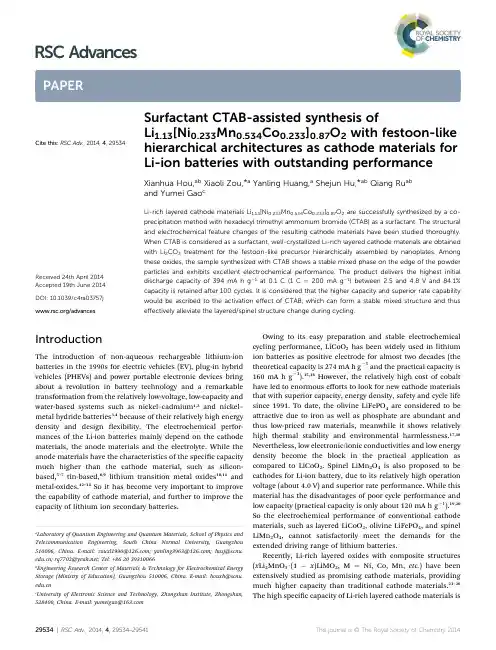
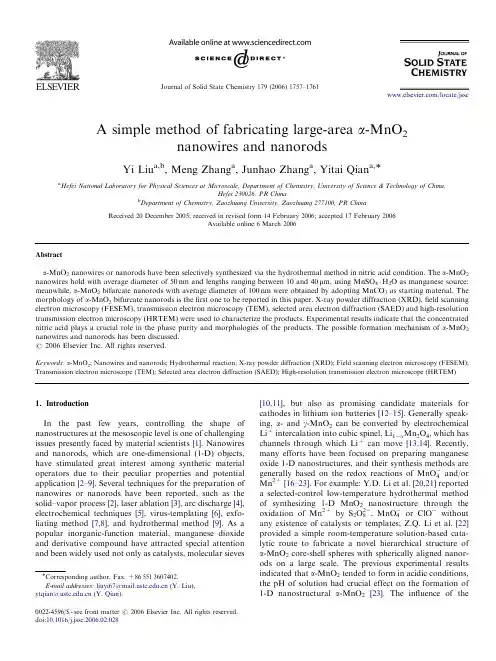
Journal of Solid State Chemistry 179(2006)1757–1761A simple method of fabricating large-area a -MnO 2nanowires and nanorodsYi Liu a,b ,Meng Zhang a ,Junhao Zhang a ,Yitai Qian a,ÃaHefei National Laboratory for Physical Sciences at Microscale,Department of Chemistry,University of Science &Technology of China,Hefei 230026,PR ChinabDepartment of Chemistry,Zaozhuang University,Zaozhuang 277100,PR ChinaReceived 20December 2005;received in revised form 14February 2006;accepted 17February 2006Available online 6March 2006Abstracta -MnO 2nanowires or nanorods have been selectively synthesized via the hydrothermal method in nitric acid condition.The a -MnO 2nanowires hold with average diameter of 50nm and lengths ranging between 10and 40m m,using MnSO 4ÁH 2O as manganese source;meanwhile,a -MnO 2bifurcate nanorods with average diameter of 100nm were obtained by adopting MnCO 3as starting material.The morphology of a -MnO 2bifurcate nanorods is the first one to be reported in this paper.X-ray powder diffraction (XRD),field scanning electron microscopy (FESEM),transmission electron microscopy (TEM),selected area electron diffraction (SAED)and high-resolution transmission electron microscopy (HRTEM)were used to characterize the products.Experimental results indicate that the concentrated nitric acid plays a crucial role in the phase purity and morphologies of the products.The possible formation mechanism of a -MnO 2nanowires and nanorods has been discussed.r 2006Elsevier Inc.All rights reserved.Keywords:a -MnO 2;Nanowires and nanorods;Hydrothermal reaction;X-ray powder diffraction (XRD);Field scanning electron microscopy (FESEM);Transmission electron microscope (TEM);Selected area electron diffraction (SAED);High-resolution transmission electron microscope (HRTEM)1.IntroductionIn the past few years,controlling the shape of nanostructures at the mesoscopic level is one of challenging issues presently faced by material scientists [1].Nanowires and nanorods,which are one-dimensional (1-D)objects,have stimulated great interest among synthetic material operators due to their peculiar properties and potential application [2–9].Several techniques for the preparation of nanowires or nanorods have been reported,such as the solid–vapor process [2],laser ablation [3],arc discharge [4],electrochemical techniques [5],virus-templating [6],exfo-liating method [7,8],and hydrothermal method [9].As a popular inorganic-function material,manganese dioxide and derivative compound have attracted special attention and been widely used not only as catalysts,molecular sieves[10,11],but also as promising candidate materials for cathodes in lithium ion batteries [12–15].Generally speak-ing,a -and g -MnO 2can be converted by electrochemical Li +intercalation into cubic spinel,Li 1Àx Mn 2O 4,which has channels through which Li +can move [13,14].Recently,many efforts have been focused on preparing manganese oxide 1-D nanostructures,and their synthesis methods are generally based on the redox reactions of MnO 4Àand/orMn 2+[16–23].For example:Y.D.Li et al.[20,21]reported a selected-control low-temperature hydrothermal method of synthesizing 1-D MnO 2nanostructure through theoxidation of Mn 2+by S 2O 82À,MnO 4Àor ClOÀwithout any existence of catalysts or templates;Z.Q.Li et al.[22]provided a simple room-temperature solution-based cata-lytic route to fabricate a novel hierarchical structure of a -MnO 2core-shell spheres with spherically aligned nanor-ods on a large scale.The previous experimental results indicated that a -MnO 2tended to form in acidic conditions,the pH of solution had crucial effect on the formation of 1-D nanostructural a -MnO 2[23].The influence of the/locate/jssc0022-4596/$-see front matter r 2006Elsevier Inc.All rights reserved.doi:10.1016/j.jssc.2006.02.028ÃCorresponding author.Fax:+865513607402.E-mail addresses:liuyi67@ (Y.Liu),ytqian@ (Y.Qian).anion on growth of the products had been investigated by Kijima et al.[19],and their results showed that a -MnO 2could be prepared in concentrated H 2SO 4rather than HCl or HNO 3.Thus far,the synthesis of a -MnO 2nanowires or nanorods has seldom been reported under concentrated nitric acidic conditions.Here we report a novel,large-area synthesis method for obtaining nanowires and nanorods with uniform sizes.The a -MnO 2nanowires have average diameter of 50nm and lengths of 10–40m m,using MnSO 4ÁH 2O as manganese source;meanwhile,a -MnO 2bifurcate nanorods with average diameter of 100nm were obtained by adopting MnCO 3as starting material.In our presentation,we choose concentrated nitric acid as acid source to tune the pH of the system.Our experiments show that pure-phase a -MnO 2can be readily obtained in a wide range of nitric acid concentrations.This result may be a useful comple-mentarity to previous experimental results that a -MnO 2could be only produced in H 2SO 4surroundings.2.Experimental procedureAll the reagents of analytical grade were purchased from Shanghai Chemical Reagent Company and used without further purification.In a typical procedure,1mmol MnSO 4ÁH 2O or MnCO 3and 2mmol KClO 3powders were successively put into a beaker with 15mL concen-trated nitric acid,the solution was magnetically stirred for 20min at 801C to form brown colloid.The slurry solution was transferred into a 50mL stainless-steel autoclave with a Teflon-liner,the beaker was washed with 25–30mL distilled water,and washing solution was put into above-mentioned Teflon-liner.The autoclave was sealed and maintained at 1201C for 12h,then air cooled to room temperature.The brown products were filtered off,washed several times with distilled water and absolute ethanol,and then dried in vacuum at 801C for 1h.The X-ray powder diffraction (XRD)pattern of the as-prepared samples was determined using a Philips X’Pert PRO SUPER X-ray diffractometer equipped with graphitemonochromatized Cu K a radiation (l ¼1:541874A)in the 2y ranging from 101to 701.The morphology and size of the final products were determined by field scanning electron microscopy (FESEM)images,taken with JEOL-6700F scanning electronic microanalyzer.Transmission electron microscope (TEM)image and selected area electrondiffraction (SAED)pattern,which were characterized by Hitachi H-800TEM with a tungsten filament and an accelerating voltage of 200kV.High-resolution transmis-sion electron microscope (HRTEM)image was recorded on a JEOL 2010microscope.The samples used for TEM and HRTEM characterization were dispersed in absolute ethanol and were ultrasonicated before observation.3.Results and discussionThe synthesis of a -MnO 2nanowires and nanorods is based on the hydrothermal method in a strong acidic (nitric acid)circumstance.The experimental results by using nitric acid as acidification agent,different manganese sources,and KClO 3as the oxidizer are summarized in Table 1.Under our experimental conditions,the different size and morphological products can be obtained by varying the concentration of nitric acid.From this table we can see that only under concentrated nitric acid condition pure a -MnO 2can be obtained.The volume of concentrated nitric acid can be in the range of 3–20mL.The yields and morphology change greatly when different amounts of nitric acid were introduced.We found that the most optimal conditions of obtaining uniform a -MnO 2nanowires were fixed on 15mL concentrated nitric acid and reaction temperature of 1201C.Moreover,when different Mn compounds were selected as starting materi-als,the size and morphologies can be changed greatly,as shown in the lines 1and 4of Table 1.The result of experiments clearly indicates concentrated nitric acid plays a crucial role in the formation of a -MnO 2with 1-D structure.The phase and purity of the products were firstly examined by XRD.Fig.1shows a typical XRD pattern of the as-synthesized samples at 1201C for 12h,all the reflection peaks can be readily indexed to body-centered tetragonal a -MnO 2phase (space group I 4/m ),with latticeconstants of a ¼9:816A,and c ¼2:853A,which are in agreement with the standard values (JCPDS 72-1982,a ¼9:815A;c ¼2:847A Þ.No other phase was detected in Fig.1indicating the high purity of the final products.The morphologies and structure information were further obtained from FESEM,TEM and SAED.Fig.2provides FESEM images of the as-prepared a -MnO 2single-crystal nanowires.Figs.2(a)and (b)are the low-and high-magnification FESEM images of the as-prepared a -MnO 2Table 1Summary of the results on the products obtained under different manganese sources,the content of concentrated nitric acid and reaction temperature for 12h,using KClO 3as the oxidizer Sample no.Manganese source Concentrated nitric acid (mL)Reaction temperature (1C)Product morphology 1MnSO 4ÁH 2O 15120a -MnO 2nanowires 2MnSO 4ÁH 2O 0120Nonexistence of MnO 23MnSO 4ÁH 2O 0180Minor b -MnO 24MnCO 315120Flowery a -MnO 2nanorods 5MnCO 3120Nonexistence of MnO 2Y.Liu et al./Journal of Solid State Chemistry 179(2006)1757–17611758single-crystal nanowires when MnSO 4ÁH 2O served as manganese source.These images show that the products of a -MnO 2consisted of a large quantity of uniform nanowires,with diameters of 50nm and lengths up to several hundreds of micrometers.Fig.3(a)shows the TEM image of as-prepared a -MnO 2nanowires,and the TEM images further demonstrate that the obtained product has a uniform wire-like morphology.The results reveal the product of a -MnO 2was composed of nanowires.The diameters and lengths of nanowires were consistent with(541)(002)(521)(600)(411)(510)(321)(301)(420)(330)(211)(400)(310)(220)(101)(200)(110)i n t e n s i t y2θ/degreeFig.1.Typical XRD pattern of as-prepared a -MnO 2.Fig.2.Low-magnification FESEM image (a)and high-magnification FESEM image (b)of a -MnO 2nanowires (MnSO 4ÁH 2O as manganesesource).Fig.3.TEM images of as-prepared single-crystal a -MnO 2nanowires (a),TEM image (b),SAED pattern (c)and HRTEM image (d)of the single a -MnO 2nanowire.Y.Liu et al./Journal of Solid State Chemistry 179(2006)1757–17611759those of FESEM results.The TEM image (Fig.3(b))of representative single nanowires and HRTEM observation for individual nanowire provide additional insight into the structure of a -MnO 2with MnSO 4ÁH 2O as manganese source.The typical SAED pattern of the single a -MnO 2nanowire is shown in the inset of Fig.3(c).Fig.3(d)is the HRTEM image taken from the single a -MnO 2nanowire,which shows the clearly resolved lattice fringes.Theseparated spacings of 2.73and 3.12Acorrespond to ð101Þand (310)planar of a -MnO 2,respectively.This image clearly reveals that the as-synthesized nanowire has no defect of dislocation and further substantiates that the nanowires are single crystalline,which is consistent with the SAED pattern.According to HRTEM image and SAED pattern recorded on the single a -MnO 2nanowire,the deduced growth direction of nanowire is ½101 .If MnCO 3was introduced into the reaction system,the products are mainly composed of nanorods,as revealed by the corresponding FESEM images.Figs.4(a)and (b)are the low-and high-magnification FESEM images of the as-prepared a -MnO 2nanorods with MnCO 3as manganese source.The low-magnification FESEM image (Fig.4(a))reveals that the product of a -MnO 2is consisted of a large quantity of flowery nanorods with average diameter of 100nm.Fig.4(b)is the high-magnification FESEM image of the as-prepared a -MnO 2,in which we seem to observe obvious features of bifurcate rod-like structure.It is worth to note that the morphology of a -MnO 2bifurcate nanorods has never been reported paring Figs.4(a)and (b)to Figs.2(a)and (b),it can be found that the nanowires with MnSO 4ÁH 2O as manganese source are much slenderer than the bifurcate nanorods with MnCO 3as manganese source.Generally,pH is believed to have great impact on the crystal forms of final products [17,19,24,25].In our experiment,a series of hydrothermal synthesis were carried out in a wide range of acidity with pH value less than 7,we found that the final products to be a -MnO 2nanowires or nanorods with 1-D morphology whether MnSO 4ÁH 2O or MnCO 3as manganese source.Therefore,this method is very effective for the large-scale synthesis of a -MnO 2with 1-D nanostructures.The influence of the reaction time on the growth of the nanowires and nanorods was investigated.The correspond-ing samples were tested by FESEM.Fig.5shows FESEM images of the as-obtained samples measured (a)after 0.5h,(b)after 3h,(c)after 6h,(d)after 12h,and other conditions kept constant at the same time.Thereinto,Figs.5(a)–(d)are FESEM images of the products with MnSO 4ÁH 2O as manganese source.As can be seen,the reaction lasted for 0.5h;the products were composed of aggregated particles (see Fig.5(a)).When the reaction timeFig.4.Low-magnification FESEM image (a)and high-magnification FESEM image (b)of a -MnO 2nanorods (MnCO 3as manganesesource).Fig.5.The FESEM images of products obtained by heating in the acidic solution for various reaction times,MnSO 4ÁH 2O (a–d)as manganese source:(a)0.5h,(b)3h,(c)6h,(d)12h and MnCO 3(e–h)as manganese source:(e)0.5h,(f)3h,(g)6h,(h)12h.Y.Liu et al./Journal of Solid State Chemistry 179(2006)1757–17611760prolonged to3h,on the surfaces of these particles,lamellar structures appeared,and some of these lamellar split to tiny nanowires,indicating the beginning of the formation of a-MnO2nanowires(see Fig.5(b)).This process continued and more nanowires formed after6h(see Fig.5(c)).Until the reaction time was extended to12h,most of the products are nanowires with average diameter of50nm and lengths ranging between10and40m m,as shown in Fig.5(d).Further elongating the reaction time shows little effects on the size and phase-purity of the products. This growth process is similar to the results of C.Z.Wu et al.[26],we call this a‘‘rolling-broken-growth’’process. According to above results and previous research [20,21,27],the possible formation mechanism of a-MnO2 nanowires by adopting MnSO4ÁH2O as manganese source could be explained as follows:(1)when temperature was maintained at801C,the interaction of KClO3and manganese source with Mn2+ion happened only when concentrated nitric acid exists.In the synthetic process,a large number of the MnO2colloidal particles had been formed in concentrated nitric acid before hydrothermal operation.(2)Under hydrothermal conditions,owing to the absence of surfactants,the MnO2colloidal particles are prone to aggregate and form bigger particles.(3)The surface of aggregated big particles grows gradually into sheets of a-MnO2with lamellar structure through an elevated temperature and pressure,and then these sheets of a-MnO2will curl by extending reaction time to form a-MnO21-D nanostructres.(4)Much evidence has demonstrated that the lamellar structure had a strong tendency to form1-D nanostructures[20,27].The structure of a-MnO2comprises a macromolecular lamellar net with octahedral[MnO6]units coordinated Mn and O atoms [20],which can give rise to formation of1-D nanostruc-tures.As the layer structure of a-MnO2is in a metastable state,these sheets of a-MnO2with lamellar structure split into nanowires.(5)Anisotropic nature of crystal growth makes thefinal products turn into a large number of uniform a-MnO2nanowires.Moreover,we found when MnCO3serves as manganese source,a similar growth procedure was observed,as shown in Figs.5(e)–(h).We believe this a-MnO21-D nanostructural formation process is universal despite different manganese sources were involved in the hydrothermal process.This observation may spread to other nanomaterials synthesis.The above mechanism is in good agreement with our experiment results.4.ConclusionIn summary,a-MnO2nanowires and nanorods with a uniform diameter have been successfully synthesized on a large scale via a simple nitric-acid-assisted hydrothermal process at low temperature.It belongs tofirstly report that the morphology of a-MnO2bifurcate nanorods can be acquired when MnCO3serves as manganese source.The concentrated nitric acid plays a crucial role in the formation of a-MnO2nanowires and nanorods.This experimental result is different from the previous conclu-sion that the concentrated nitric acid seems to be an unfavorable condition to form a-MnO2.This observation may be expanded to synthesize other nanomaterials. AcknowledgmentsFinancial support from the National Natural Science Foundation of China and the973Project of China is greatly appreciated.References[1]A.P.Alivisatos,Science271(1996)933.[2]Y.Wu,P.Yang,Chem.Mater.12(2000)605.[3](a) A.M.Morales,C.M.Lieber,Science279(1998)208;(b)M.S.Gudiken,C.M.Lieber,J.Am.Chem.Soc.122(2000)8801.[4](a)S.Iijima,Nature354(1991)56;(b)T.Seeger,P.Kohler-Redlich,M.Ruhle,Adv.Mater.12(2000)279.[5]Y.Zhou,S.H.Yu,X.P.Cui,C.Y.Wang,Z.Y.Chen,Chem.Mater.11(1999)545.[6]C.Mao,D.J.Solis,B.D.Reiss,S.T.Kottmann,R.Y.Sweeney,A.Hayhurst,G.Georgiou,B.Iverson,A.M.Belcher,Science303(2004) 213.[7]G.H.Du,L.-M.Peng,Q.Chen,S.Zhang,W.Z.Zhou,Appl.Phys.Lett.83(2003)1638.[8]G.H.Du,Q.Chen,Y.Yu,S.Zhang,W.Z.Zhou,L.M.Peng,J.Mater.Chem.14(2004)1437.[9]G.H.Du,Q.Chen,R.C.Che,L.M.Peng,Appl.Phys.Lett.79(2001)3702.[10]M.M.Thackeray,Prog.Solid State Chem.25(1997)1.[11]A.R.Armstrong,P.G.Bruce,Nature381(1996)499.[12]B.Ammundsen,J.Paulsen,Adv.Mater.13(2001)943.[13]Q.Feng,H.Kanoh,K.Ooi,J.Mater.Chem.9(1999)319.[14]L.I.Hill,A.Verbaere,D.Guyomard,J.Power Sources226(2003)119.[15]M.M.Thackeray,J.Am.Ceram.Soc.82(1999)3347.[16]Y.F.Shen,R.P.Zerger,S.L.Suib,L.McCurdy,D.I.Potter,C.L.O’Young,Science260(1993)511.[17]R.N.DeGuzman,Y.F.Shen,h,S.L.Suib,C.L.O’Young,S.Levine,J.M.Newsam,Chem.Mater.6(1994)815.[18]M.Benaissa,M.Jose-Yacaman,T.D.Xiao,P.R.Strutt,Appl.Phys.Lett.70(1997)2120.[19]N.Kijima,H.Yasuda,T.Sato,Y.Yoshimura,J.Solid State Chem.159(2001)94.[20]Y.D.Li,X.L.Li,R.R.He,J.Zhu,Z.X.Deng,J.Am.Chem.Soc.124(2002)1411.[21]X.Wang,Y.D.Li,Chem.Eur.J.9(2003)300.[22](a)Z.Q.Li,Y.Ding,Y.J.Xiong,Q.Yang,Y.Xie,mun.(2005)918;(b)Z.Q.Li,Y.Ding,Y.J.Xiong,Y.Xie,Cryst.Growth Des.5(2005)1953.[23](a)Y.Q.Gao,Z.H.Wang,J.X.Wan,G.F.Zou,Y.T.Qian,J.Cryst.Growth279(2005)415;(b)Y.Chen,C.Liu,F.Liu,H.M.Cheng,J.Alloy Compd.19(2005)282.[24]J.Luo,S.L.Suib,J.Phys.Chem.B101(1997)10403.[25]T.D.Xiao,P.R.Strutt,M.Benaissa,H.Chen, B.H.Kear,Nanostruct.Mater.10(1998)1051.[26]C.Z.Wu,Y.Xie,D.Wang,J.Yang,T.W.Li,J.Phys.Chem.B107(2003)13583.[27]Y.D.Li,X.L.Li,Z.X.Deng,B.C.Zhou,S.S.Fan,J.W.Wang,X.M.Sun,Angew Chem.Int.Ed.Engl.41(2002)333.Y.Liu et al./Journal of Solid State Chemistry179(2006)1757–17611761。
JournalofColloidandInterfaceScience299(2006)396–402www.elsevier.com/locate/jcis
Manufactureoflargeuniformdropletsusingrotatingmembraneemulsification
GoranT.Vladisavljevi´ca,∗,RichardA.WilliamsbaInstituteofFoodTechnologyandBiochemistry,FacultyofAgriculture,UniversityofBelgrade,P.O.Box127,YU-11081Belgrade-Zemun,Serbia&Montenegro
bInstituteofParticleScience&Engineering,SchoolofProcess,Environmental&MaterialsEngineering,UniversityofLeeds,ClarendonRoad,Leeds,LS29JT,
UnitedKingdom
Received11November2005;accepted28January2006Availableonline23March2006
AbstractAnewrotatingmembraneemulsificationsystemusingastainlesssteelmembranewith100µmlaserdrilledporeswasusedtoproduceoil/wateremulsionsconsistingof2wt%Tween20asemulsifier,paraffinwaxasdispersedoilphaseand0.01–0.25wt%Carbomer(CarbopolETD2050)asstabilizer.Themembranetube,1cmindiameter,wasrotatedinsideastationaryglasscylinder,diameterof3cm,ataconstantspeedintherange50–1500rpm.Theoilphasewasintroducedinsidethemembranetubeandpermeatedthroughtheporouswallmovingradiallyintothecontinuousphaseintheformofindividualdroplets.Increasingthemembranerotationalspeedincreasedthewallshearstresswhichresultedinasmalleraveragedropletdiameterbeingproduced.Foraconstantrotationalspeed,theaveragedropletdiameterincreasedasthestabilizercontentinthecontinuousphasewaslowered.TheoptimalconditionsforproducinguniformemulsiondropletswereaCarbomercontentof0.1–0.25wt%andamembranerotationalspeedof350rpm,underwhichtheaveragedropletdiameterwas105–107µmandverynarrowcoefficientsofvariationof4.8–4.9%.Amodeldescribingtheoperationispresentedanditisconcludedthatthemethodologyholdspotentialasamanufacturingprotocolforbothcoarseandfinedropletsandcapsules.©2006ElsevierInc.Allrightsreserved.
Keywords:Membraneemulsification;Monodisperseemulsion;Rotatingmembraneemulsification;Stainlesssteelmembrane
1.IntroductionConventionalemulsificationdevices,suchashigh-pressurehomogenizersandrotor–statorsystems,generallyuseinhomo-geneousextensionalandshearforcesandhighenergyinputsperunitvolumetorupturedroplets[1].Asaresulttheygener-ateemulsionswithwidedropletsizedistributionsandrelativelysmallmeandropletsizes,uptoseveralmicrometers.Further,batch-to-batchconsistencyisoftenpoorevenwhensimilarex-perimentalconditionsaredeployed.However,someimportantpotentialusesofemulsionsrequiretheproductionoflargeruni-formdropletswithameansizeranginguptoseveralhundredsofmicrometers,e.g.,inthemanufactureofavarietyofcoherentandstructuredmicroparticlesandmicrocarriersthroughpoly-*Correspondingauthor.Fax:+38111199711.E-mailaddresses:gtvladis@afrodita.rcub.bg.ac.yu(G.T.Vladisavljevi´c),r.a.williams@leeds.ac.uk(R.A.Williams).merization,gelation,andothersecondaryreactions/processesintheemulsifieddroplets.Developmentofemulsificationmethodsforproducinguni-formdropletsarerootedinoneoftwopossiblemanufacturingapproaches[2]:
–equipmentdesignsthatseekto(a)reduceofprocesslengthscalesoftheturbulentperturbationsintheshearing/mixingprocessesthatrupturetheliquids,and(b)enhancethede-greeofuniformityoftheshearwithintheemulsifyingchamber;–thecreationofdropletsindividually(drop-by-drop).
Ourworkhereisconcernedwiththesecondroute.Severalsingle-droptechnologieshavebeendevelopedforgeneratinguniformdroplets,suchasinjectionofliquidthroughacap-illaryintoanotherco-flowingimmisciblefluid[3,4],penetra-tionofdispersedphasethroughmicrofabricatedparallelsilicon
0021-9797/$–seefrontmatter©2006ElsevierInc.Allrightsreserved.doi:10.1016/j.jcis.2006.01.061G.T.Vladisavljevi´c,R.A.Williams/JournalofColloidandInterfaceScience299(2006)396–402397channels[5]orinterconnectedchannelnetworkinmicrofluidicdevices[6,7],andinjectionofdispersedphasethroughmicro-porousmembranesofdifferentnature(glass,ceramic,metal-lic,polymeric)[8–14].Productionofvariousparticulateprod-ucts,suchasmicrospheresandmicrocapsules,usingmembraneemulsificationrouteswasrecentlyreviewedbyVladisavljevi´candWilliams[15].Somespecificattributesofexistingsystemswillbecon-sideredbriefly.‘Directmembraneemulsification’involvesthedirect(insitu)formationofdropletsbyextrudingapuredis-persedphasethroughthemembraneintothecontinuousphase.In‘premixmembraneemulsification,’fineemulsionsarepro-ducedbyhomogenizationofcoarselyemulsifiedfeedsthroughthemembrane[16].Inordertostimulatedropletdetachmentfromtheporeoutletsinthedirectemulsification,shearstressisgeneratedatthemembrane/continuousphaseinterfacebyre-circulatingthecontinuousphasethroughthemembraneincrossflow[8]orbyagitationinastirringvessel[17].ZhuandBarrow[18]haveintroducedmembranevibration,throughpiezoactu-ation,tohelpthedetachmentofdropletsandprovideanextracontroloverdropletdetachmentincrossflowmembraneemulsi-fication.Thepreliminaryresultsshowedthatavibratingmem-branehadasignificanteffectinreducingtheaveragesizeofemulsiondropletsbutonlyatverylowfrequencies(0–100Hz).ThetypicalcoefficientsofvariationCV1ofdropletsizesinthedirectemulsificationusingporousglassmembranesincrossfloworstirringsystemsareintherangeof7–20%andthemeandropletsizesrangefromlessthan1µmtoover60µm[15].ThetypicalCVvaluesinmicrochannelemulsi-ficationarelessthan5%andthemeandropletsizesrangefromseveralmicronsto100µm[19].Performingdirectemul-sificationusingrectilinearsiliconmicrochannelswithoblongcrosssection,Kobayashietal.[20]obtainedhighlyuniformdropletswiththeCVvaluesoflessthan2%.Theyconcludedthatanelongatedcrosssectionofthechannelscontributedde-cisivelytotheformationofmonodisperseddropletswithandwithoutacontinuousphaseflow.Inordertoproduceemul-siondropletswithaCVbelow2%,theslotaspectratioofthestraight-throughmicrochannelsshouldexceedacriticalvalueof3[20].SchadlerandWindhab[21,22]havestudiedcontinuousproductionofW/Oemulsionsusingarotatingnickelmem-branewithcarboncoatingdepositedontheporoussubstratebytheplasma-enhancedchemicalvapourdeposition(PECVD)method.Therotatingmembranewasmountedcoaxiallyinsideanoutercylinderandthedispersedphasewasforcedthroughthemembraneatafixedflowrateof12l/h.Thecontinuousphasewaspumpedthroughthegapatdifferentflowratestoad-justthedispersedphasefraction.Withincreasingthegapwidththedropletsizedecreased,butthedispersephasevolumefrac-tiondidnotinfluencethedropletsize[22].Therotatingmembraneconcepthasbeenappliedearlierindynamicmembranefilters,whichcanbedesignedasrotating1ForaspecificsizedistributionthecoefficientofvariationisdefinedasCV=(σ/dav)×100,whereσisthestandarddeviationofthedropletdiametersanddavisthenumber-averagedropletdiameter.diskmembranes[23]orrotatingcylindricalmembranes[24].Thesefiltersaremostapplicabletotheclarificationofveryhighconcentrationsuspensionsandtheseparationofbiologi-calproducts[25].Anovelrotatingmembraneemulsificationsystemutilizingasmalldiameterstainlesssteelmembranewithuniformlyspacedlaserdrilledporeshasbeeninvestigatedinthiswork.Fig.1Ashowsacontinuousmembraneemulsificationsystemwitharo-tatingcylindricalmembranemountedinastationaryvessel.Apurecontinuousphaseisslowlypassedupwardsintotheannulusbetweenthestationaryvesselandthemembranetubeandaproductemulsionisdischargedfromthetopoftheves-sel.Theshearstressisdevelopedbyrotatingthemembraneratherthanbyflowingthecontinuousphase,sincethecross-flowvelocityisnegligible.Therequirementforcirculationofthecontinuousphasealongthemembranesurfacecanthusbetotallyavoided.Comparedwithcrossmembraneemulsificationmethods[2,14]thiscanbeparticularlyadvantageoustothepro-ductionofcoarseemulsionsandfragilestructuredproducts,inwhichthedropletsand/orparticlesaresubjecttobreakageduringthepumpcirculation.Thedispersedphasepassesra-diallythroughtheporousmembranewallandformsdropletsmovingintothecontinuousphase.Athighrotationalspeedsafoot-bearingcanbeusedtoavoidtheexcessivevibrationofthemembranetube.Theexperimentalbatchrotatingmem-branesystemusedinthisworkforemulsificationexperimentsisshowninFig.1B,andwillbedescribedfurtherinSection2.Inthiscaseasmallergapisusedalthoughtheconditionsem-ployeddidnotentertheregimeofTaylorvorticesintheannu-lus.